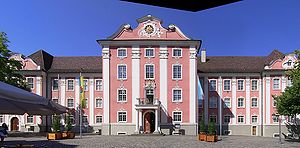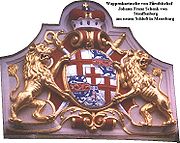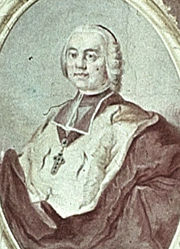
Neues Schloss (Meersburg)
Encyclopedia

Meersburg
Meersburg is a town of Baden-Württemberg in the southwest of Germany at Lake Constance.It is famous for its charming medieval city. The lower town and upper town are reserved for pedestrians only and connected by two stairways and a steep street .-History:The name of the town means "Burg on the...
near Lake Constance
Lake Constance
Lake Constance is a lake on the Rhine at the northern foot of the Alps, and consists of three bodies of water: the Obersee , the Untersee , and a connecting stretch of the Rhine, called the Seerhein.The lake is situated in Germany, Switzerland and Austria near the Alps...
in Baden-Württemberg, Germany. From its construction in 1750 until the bishopric was dissolved in 1803 it was the seat of the Prince-Bishop
Prince-Bishop
A Prince-Bishop is a bishop who is a territorial Prince of the Church on account of one or more secular principalities, usually pre-existent titles of nobility held concurrently with their inherent clerical office...
of Constance
Bishopric of Constance
The Bishopric of Constance was a diocese of the Roman Catholic Church and ecclesiastical state of the Holy Roman Empire that existed from about 585 until 1821. Its seat was Konstanz at the western end of Lake Constance in the south-west corner of Germany...
.
History

When Hugo Damian von Schönborn, who was already Bishop of Speyer
Bishopric of Speyer
The Bishopric of Speyer was a state, ruled by Prince-Bishops, in what is today the German state of Rhineland-Palatinate. It was secularized in 1803...
and had already built Schloss Bruchsal there, took over the seat at Meersburg in 1740 he wanted to improve the Neues Schloss. He brought in the master builder Johann Georg Stahl from Bruchsal
Bruchsal
Bruchsal is a city at the western edge of the Kraichgau, approximately 20 km northeast of Karlsruhe in the state of Baden-Württemberg, Germany...
to turn the Schloss into a more impressive and elegant building. Following plans from Balthasar Neumann
Balthasar Neumann
Johann Balthasar Neumann , also known as Balthasar Neumann, was a [German] military artillery engineer and architect who developed a refined brand of Baroque architecture, fusing Austrian, Bohemian, Italian, and French elements to design some of the most impressive buildings of the period,...
, Johann built an impressive staircase and decorated the castle.

Fresco
Fresco is any of several related mural painting types, executed on plaster on walls or ceilings. The word fresco comes from the Greek word affresca which derives from the Latin word for "fresh". Frescoes first developed in the ancient world and continued to be popular through the Renaissance...
painter Gottfried Bernhard Göz from Augsburg
Augsburg
Augsburg is a city in the south-west of Bavaria, Germany. It is a university town and home of the Regierungsbezirk Schwaben and the Bezirk Schwaben. Augsburg is an urban district and home to the institutions of the Landkreis Augsburg. It is, as of 2008, the third-largest city in Bavaria with a...
(1708–1774) and the sculptor
Sculpture
Sculpture is three-dimensional artwork created by shaping or combining hard materials—typically stone such as marble—or metal, glass, or wood. Softer materials can also be used, such as clay, textiles, plastics, polymers and softer metals...
Joseph Anton Feuchtmayer
Joseph Anton Feuchtmayer
Joseph Anton Feuchtmayer was an important Rococo stuccoist and sculptor, active in southern Germany and Switzerland....
(1696–1770).

Franz Anton Bagnato
Franz Anton Bagnato, , also known as Francesco Antonio Bagnato, was the son of architect Johann Caspar Bagnato. Franz Anton Bagnato was born in Altshausen. Like his father he was an architect active during the Baroque period...
s. The already dilapidated stairway had to be restored. The baroque facade of the castle was redone in the Rococo
Rococo
Rococo , also referred to as "Late Baroque", is an 18th-century style which developed as Baroque artists gave up their symmetry and became increasingly ornate, florid, and playful...
style, with enlarged windows, additional decoration around the windows and new gables.
The interior decoration is the work of the Mainz
Mainz
Mainz under the Holy Roman Empire, and previously was a Roman fort city which commanded the west bank of the Rhine and formed part of the northernmost frontier of the Roman Empire...
artist Giuseppe Appiani
Giuseppe Appiani
Giuseppe Appiani was an Italian painter of the Neoclassic periods. He was born in Vaprio d'Adda, near Milan, where he was mainly active. Hi parents moved to Monza, where his first mentor was the painter Giovanni Maria Gariboldi. At age 21, he moved to Milan, where he worked in the studios of...
(c. 1705–1786) and the sculptor Carlo Luca Pozzi (1735–1803). Among the paintings by Appiani are two enormous paintings over the Grand Staircase Verherrlichung des Fürstbischofs und des Hochstift (English:Glorification of the Prince-Bishops and the Diocese) from 1761 and over the ballroom Die Verehrung der göttlichen Vorsehun (English: The worship of the divine providence) from 1762.
Due to the Secularization
German Mediatisation
The German Mediatisation was the series of mediatisations and secularisations that occurred in Germany between 1795 and 1814, during the latter part of the era of the French Revolution and then the Napoleonic Era....
in 1803, the Neues Schloss was the seat of the Prince-Bishops of Constance for only about 50 years.

Gengenbach
Gengenbach is a town in the district of Ortenau, Baden-Württemberg, Germany and a popular tourist destination on the western edge of the Black Forest with about 11,000 inhabitants....
after 1937.
From 1937–1945 the castle was the site of the Bodenseeschule (High school for troubled young men). Following World War II it was used as barracks for French troops.
Today the castle is home to several museums. In addition to the Town Gallery (Städtische Galerie) and the Dornier Museum, which take up the 2nd floor, the New Palace is also home to the Palace Museum of the Prince Bishops (Fürstbischöfliche Schlossmuseum) on the 3rd floor. It offers the opportunity to view the residential and representation rooms of the prince bishops refurnished with contemporary appointments from that age.
Castle location
The castle is located on a hill over the Lake ConstanceLake Constance
Lake Constance is a lake on the Rhine at the northern foot of the Alps, and consists of three bodies of water: the Obersee , the Untersee , and a connecting stretch of the Rhine, called the Seerhein.The lake is situated in Germany, Switzerland and Austria near the Alps...
. In the rear of the castle is a garden terrace with an excellent view of the lower city, the ferry port and the Swiss
Switzerland
Switzerland name of one of the Swiss cantons. ; ; ; or ), in its full name the Swiss Confederation , is a federal republic consisting of 26 cantons, with Bern as the seat of the federal authorities. The country is situated in Western Europe,Or Central Europe depending on the definition....
coast of Lake Constance. Access to the terrace is on the ground floor of the castle or through a staircase located near the bridge to the Burg Meersburg
Burg Meersburg
Burg Meersburg, also known as the Alte Burg , in Meersburg on Lake Constance in Baden-Württemberg, Germany is the oldest inhabited castle in Germany. The central tower was first built during the 7th century, though the original structure is no longer visible...
, which is closed by a wrought iron gate.
On the city side there is a large plaza, the Schlossplatz. In the middle of the castle facade, there is a large clock with the god of time, Chronos
Chronos
In Greek mythology, Chronos in pre-Socratic philosophical works is said to be the personification of time. His name in Greek means "time" and is alternatively spelled Chronus or Khronos.Chronos was imagined as an incorporeal god, serpentine in form, with three heads—those of a man, a bull, and...
. On the left side of the castle is the entrance to the castle chapel which is currently used by the Evangelical Church in Germany
Evangelical Church in Germany
The Evangelical Church in Germany is a federation of 22 Lutheran, Unified and Reformed Protestant regional church bodies in Germany. The EKD is not a church in a theological understanding because of the denominational differences. However, the member churches share full pulpit and altar...
.

